Results 9,501 to 9,510 of 12091
Thread: Anandtech News
-
05-27-19, 12:13 AM #9501
Anandtech: Arm's New Cortex-A77 CPU Micro-architecture: Evolving Performance
2018 was an exciting year for Arm’s own CPU designs. Last year in May we saw the release of the Cortex-A76 and the subsequent resulting silicon in the form of the Kirin 980 as well as Snapdragon 855 SoCs. We were very impressed by the IP, and Arm managed to deliver on all its performance, efficiency and area promises, resulting in some excellent SoCs and devices powering most of 2019’s flagship devices.
This year we follow-up with another TechDay disclosure, and this time around we’re uncovering Arm’s follow-up to the Cortex-A76: the new Cortex-A77. The new generation is a direct evolution of last year’s major microarchitecture introduction, and represents the second instance of Arm’s brand-new Austin core family. Today we’ll analyse how Arm has pushed the IPC of its new microarchitecture and how this will translate into real performance for upcoming late-2019/early-2020 SoCs and devices.
More...
-
05-27-19, 04:24 AM #9502
Anandtech: Acer Announces ConceptD 7 Notebook: Acer Goes Pro With Quadro RTX
Acer is launching not just a new laptop at Computex, but also a new brand. The ConceptD 7 Notebook is the first in a new series of high-end computers targeting creators such as graphics designers and engineers. The ConceptD 7 Notebook mobile workstation is jumping into the Quadro party with the latest NVIDIA Quadro RTX 5000.
This 15.6-inch mobile workstation offers a UHD IPS display which is PANTONE validated to the Adobe RGB color space with a Delta-E of less than two. It will offer up to a 9th generation Intel Core i7 processor coupled with the NVIDIA Quadro RTX 5000, with the ability to perform real-time RED video editing at 8K resolutions.
The ConceptD 7 stays thin and light despite the powerful internals, with a 17.9 mm (0.7-inch) thickness and a 2.1 Kg (4.63 lbs) weight, so it should be very portable.
Acer will be offering both Thunderbolt 3 and mini DisplayPort for connecting up to three external displays which can be two 8K displays or three 5K displays.
Full specifications and pricing are not yet available, but the ConceptD 7 Notebook is the first in a new series of professional products from Acer carrying the ConceptD branding, and Acer will be fleshing out the lineup with desktops, more notebooks, and displays.
Source: Acer
More...
-
05-27-19, 04:24 AM #9503
Anandtech: Razer Announces Razer Blade Studio Edition: Quadro RTX And Improved Displa
Hot on the heels of NVIDIA’s announcement of their latest Quadro professional GPUs, Razer is leveraging this new technology to offer up new workstation laptops based on their popular Blade models, with the Razer Blade 15 and 17 Studio Edition. The new professional laptops offer up the classic Razer CNC machined aluminum chassis, add in some new hardware, new displays, and finish off with a gorgeous Mercury White finish.
The Razer Blade 15 Studio Edition will be offered with a UHD OLED touch display, and to meet the demands of professionals, will be available with 32 GB of RAM and 1 TB of NVMe storage. The 15-inch model will feature the Intel Core i7-9750H, with six cores, twelve threads, and a 2.6 GHz to 4.5 GHz frequency range. For graphic demands, the NVIDIA Quadro RTX 5000 is on tap, and the laptop will be loaded with NVIDIA’s Studio Drivers, which are formerly known as Creator Ready drivers and optimized for professional workflows such as Cinema 4D and Adobe products.
The Razer Blade Pro 17 Studio Edition takes the 17-inch Blade model and updates it with a new UHD 120 Hz display. Along with the NVIDIA Quadro RTX 5000, the 17-inch version gets the Core i9-9880H, which is offers eight cores, sixteen threads, and a 2.3 GHz to 4.8 GHz frequency range.
Both laptops will of course work with Razer’s Core X external GPU enclosure as well over Thunderbolt 3, if you have workloads that would benefit from dual-GPUs.
We’re waiting on full specifications from Razer, but I would expect both devices to offer at least Adobe RGB, which is something Razer already offers on several of their other laptops.
The new Studio Edition laptops will be available later this year, with pricing to be determined closer to launch.
Source: Razer
More...
-
05-27-19, 09:30 AM #9504
Anandtech: The MSI Prestige X570 Creation Motherboard: 10G LAN, PCIe 4.0 M.2 Xpander,
MSI has prepared a total of seven models for the launch of AMD's X570 chipset, but in a new series of boards focused at content creators. The new MSI Prestige X570 Creation includes an Aquantia 10 GbE networking controller, is bundled with an M.2 Xpander, and includes an impressive twelve USB 3.1 Gen2 ports on the rear panel.
The MSI Prestige X570 Creation features similar aesthetics to, and takes certain elements from, the MSI X399 Creation, and implements them onto an E-ATX sized consumer desktop model. On the rear panel cover is an RGB enabled design, with the creation logo being the centerpiece. This covers the large power delivery heatsink which features an extended design from around the MOSFETs, down the four DDR4 memory slots, and into the chipset heatsink. The chipset heatsink keeping the X570 chip cool also includes a cooling fan making this an actively cooled heatsink.
Across the southern part of the Prestige X570 Creation, is a PCB cover which gives the more a more premium look, but it also blends into the aesthetic of the chipset heatsink. On the board is three full-length PCIe 4.0 slots as well as four PCIe 4.0 x1 slots. This means that the X570 Creation supports both two-way AMD CrossFire, and two-way NVIDIA SLI multi-graphics card configurations. Exact details around the power delivery are unclear, but it looks like it could be in a 12+4 configuration. The board has two 8-pin 12 V ATX CPU power inputs, and a single 24-pin 12 V ATX motherboard power input.
With one of the most impressive rear panels for USB 3.1 Gen2 I've seen so far, the MSI Prestige X570 Creation has eleven USB 3.1 Gen2 Type-A, and a single USB 3.1 Gen2 Type-C port. There's also two USB 2.0 ports, a PS/2 combo port, and dual LAN with one being controlled by the 10 GbE Aquantia AQC107, as well as what is expected to be an Intel 1 GbE networking chip.
Gallery: MSI Prestige X570 Creation Motherboard Gallery




The MSI Prestige X570 Creation is one of two models (Prestige X570 A Pro) targeting content creators and is likely to be released sometime before AMD launches the new 3rd generation Ryzen 3000 Matisse processors.
Want to keep up to date with all of our Computex 2019 Coverage? 
Laptops
Hardware
ChipsFollow AnandTech's breaking news here!
More...
-
05-27-19, 09:30 AM #9505
Anandtech: AMD Confirms Zen 4 EPYC Codename, and Elaborates on Frontier Supercomputer
After the Computex Keynote today on stage, where AMD revealed its new Ryzen family of processors coming on 7/7, we had a chance to speak with AMD’s SVP and GM of the Datacenter and Embedded Solutions Group, Forrest Norrod. Specifically, we asked him about the ‘Road to Rome’, which AMD stated will be coming in Q3 this year. We have a full transcription of the interview planned, but a couple of key points came out of our discussion.
First, Forrest revealed/confirmed the name of the Zen 4 based EPYC processor that will go beyond Rome and Milan. That name is Genoa, which is follows the Italian naming pattern. Forrest also said that the Zen 5 product follows that pattern, but failed to elaborate what that name is. I was told that the goal with each generation is to make sure the low hanging fruit for performance on each design is taken, and that there is a continual drive for compute performance. Forrest wouldn’t comment on the timeframe for Genoa, but did state that Milan is a mid-2020 platform, and so Genoa is likely 2021/2022.
The other snippet of information I wanted to break out from the interview is about the new Frontier supercomputer that was recently announced. This machine, built with AMD CPUs and GPUs, has a goal of being the most powerful supercomputer in 2021, measuring around 1.5 ExaFLOPS, making it a truly exascale machine. It has been largely assumed that this would be a combination of Milan CPUs and Radeon Instinct GPUs, and it would be connected CPU-to-GPU and GPU-to-GPU by Infinity Fabric rather than PCIe or CCIX. Forrest explained that the CPU is not Milan – it is actually a fully custom design CPU specifically for this project.AMD EPYC CPU Codenames Gen Year Name Cores 1st 2017 Naples 32 x Zen 1 2nd 2019 Rome 64 x Zen 2 3rd 2020 Milan ? x Zen 3 4th ? Genoa ? x Zen 4 5th ? ? ? x Zen 5
Forrest clarified that this custom CPU is not in the same way that Intel defines custom – i.e. it’s not simply the same silicon with adjustments in core counts / frequency / cache. The CPU for Frontier will be a fully custom design, built with CPU-to-GPU IF links in mind, without any excess. When asked if IF is going to be a connectivity in other platforms, Forrest would only confirm that it’s the connectivity for Frontier. Though, for what it's worth, AMD announced back at the Frontier unveil that the CPU would ultimately become available for other enterprise customers as well.
As mentioned, I’ll be trying to transcribe this interview ASAP, along with our Lisa Su roundtable. Stay tuned for more of our Computex coverage.
Want to keep up to date with all of our Computex 2019 Coverage? 
Laptops
Hardware
ChipsFollow AnandTech's breaking news here!
More...
-
05-27-19, 12:08 PM #9506
Anandtech: Hands-On with Industry’s First 5G Laptop: A Lenovo with Qualcomm’s 8cx SoC
Lenovo and Qualcomm introduced the world’s first laptop with an integrated 5G modem at Computex. The convertible notebook is based on Qualcomm’s latest platform for Windows 10 on Arm systems, the Snapdragon 8cx, and further includes the company's upcoming Snapdragon X55 5G modem. The PC is expected to be available later, but Lenovo is not disclosing its exact launch timeframe.
While Qualcomm and Lenovo have always promoted these devices as being super-efficient for ‘always connected’ workflows, leveraging the smartphone modem inside, these devices have actually seen more success when advertised for all-day battery life: by putting a smartphone chip in something the size of a laptop, the substantially larger battery makes the laptop last all day, and then some more. If there’s one thing that the Qualcomm always connected PCs (ACPCs) resonates with the tech press, it’s the phenomenal battery life. Now Qualcomm wants to pair that with a slightly more powerful chip, extending the capability in CPU and GPU.
Outfitted with what seems to be a 13-inch display featuring a Full-HD resolution (for now, Lenovo says it can install any screen, even an Ultra-HD one), the Lenovo 5G notebook (or 5GPC as the manufacturer calls it) is as thin and light as the company’s convertible Yoga C630 based on Qualcomm’s previous-gen Snapdragon 850. The Yoga design housing the new Snapdragon 8cx is the same chassis design as the previous generation (the Yoga C630). This is a super thin and light laptop that I really like. The downside of the older version was always the responsiveness, and the 8cx with its higher turbo performance promises to solve some of those issues. Similar to the previous ACPCs, a full version of Windows is being used, with Windows standard software and services being optimized for the Arm cores inside the Snapdragon SoC. The complaints about the previous models were mostly in ‘instantaneous performance’ – the performance that matters most when opening up programs and affecting the user experience. The new 8cx has a higher thermal envelope and can turbo higher – the chip has a can be set to a wide all-core TDP, over and above 10W, making a substantial difference.
Overall, the laptop feels to be a bit lighter than the majority of 13-inch notebooks on the market, possibly due to the lack of a sophisticated cooling system that normally accompanies x86 CPUs used in such PCs.
Meanwhile, the computer has a keyboard that feels rather nice: the keys are easy to press, yet they are located far enough from each other to minimize typos.
Qualcomm's new 8cx chip will feature a 4+4 Kryo 495 design, paired with 10MB of L3 cache and a large shared system cache. The GPU in this case is the Adreno 680, which is a much larger version of the Adreno 640 we see on the top end Snapdragon 855 which has powered most of the major 2019 smartphones. This chip is built on 7nm, and Qualcomm states is 60% more efficient than the Snapdragon 850 in the current generation of ACPCs.
As far as specifications are concerned, Lenovo says that it can equip its 5G notebook with up to 16 GB of RAM as well as a PCIe or UFS 3.0 SSD with up to 1 TB capacity. Since the product is set to be available later, Lenovo is being pretty flexible with its specifications, but it is likely that the company will offer multiple versions of its 5G-enabled notebook priced and speced differently.
When it comes to connectivity, the Lenovo 5G supports 802.11ac Wi-Fi (this is what the 8cx SoC supports), Bluetooth 5.x, and, naturally, 2G/3G/4G (Cat 22) and 5G via the X55 modem. It is noteworthy that the notebook exclusively uses Qualcomm’s X55 modem even for non-5G networks as the manufacturer believes that this is more power efficient. On the wired side of things, the Lenovo 5G notebook has two USB Type-C ports as well as a 3.5-mm headphone jack.
At present, Lenovo is not disclose anything about the actual launch date, price, or even launch countries. As far as availability goes, the linchpin would appear to be the X55 modem, as this is Qualcomm's next-generation 5G modem that's yet to ship (as the first X50-based devices only started shipping a couple of months back). As for pricing and availability, Lenovo still has some work to do to feel out the market for what kind a premium users are willing to pay for a 5G laptop, and then where 5G service is even readily available. This is one of the reasons why Lenovo does not want to disclose an exact launch timeframe, as the company wants 5G networks to roll out first and then release the laptop once demand is there.
Want to keep up to date with all of our Computex 2019 Coverage?  Laptops
Laptops Hardware
Hardware Chips
ChipsFollow AnandTech's breaking news here!
More...
-
05-27-19, 12:08 PM #9507
Anandtech: Corsair Announces MP600 NVMe SSD With PCIe 4.0
Now that AMD has kicked off the transition to PCI Express 4.0 in the consumer PC market, peripheral vendors are racing to follow suit. Phison is on track to deliver the first PCIe 4.0-capable NVMe controller for consumer SSDs, so many of their customers are announcing products based on the new PS5016-E16 controller. Corsair is one of the first in turn to announce their drive, with the new MP600 M.2 NVMe SSD.
The specifications disclosed so far for the MP600 are still incomplete, but the most important point is that the MP600 will be launching in July alongside AMD's new Ryzen 3000 series processors and their X570 chipset, both providing PCIe 4.0 lanes. Corsair hasn't specifically committed to launching on the same 7/7 date as AMD, but even shipping in the same month is a win for Phison and their partners. No other SSD controller vendor has announced a PCIe 4.0 capable client SSD controller, and even if that changes this week during Computex, Phison will almost certainly be first to market.
The MP600 will be capable of up to 4950MB/s for sequential reads and 4250MB/s for sequential writes, both significant increases over any consumer SSD currently available, such as the MP510 it will be replacing. That performance likely only applies to the largest capacity MP600, but Corsair hasn't announced what specific capacities will be available; our guess is that the product line will go up to the same 1920GB as the MP510. The MP600 includes a simple black heatsink over the M.2 module, which may actually be necessary to hit the new higher speeds.Corsair Force Series NVMe SSD Comparison Model MP600 MP510 MP500 Form Factor double-sided
M.2 2280
(with heatsink)double-sided
M.2 2280double-sided M.2 2280 Interface NVMe, PCIe 4.0 x4 NVMe, PCIe 3.0 x4 NVMe, PCIe 3.0 x4 Controller Phison PS5016-E16 Phison PS5012-E12 Phison PS5007-E7 NAND Flash undisclosed 3D TLC Toshiba 64-layer 3D TLC Toshiba 15nm MLC Capacities ? 240GB–1920GB 120GB–960GB Sequential Read up to 4950 MB/s up to 3480 MB/s up to 3000 MB/s Sequential Write up to 4250 MB/s up to 3000 MB/s up to 2300 MB/s Random Read ? up to 610k IOPS up to 260k IOPS Random Write ? up to 570k IOPS up to 230k IOPS Warranty 5 years 5 years 3 years Write Endurance ? 1.0 DWPD 0.7 DWPD Release Date July 2019 October 2018 December 2016
Pricing for the MP600 has not yet been announced. The warranty will be the usual 5 years, but write endurance has not been announced. And, of course, the drive will be backwards-compatible with existing PCIe 3.0 systems.
Want to keep up to date with all of our Computex 2019 Coverage? 
Laptops
Hardware
ChipsFollow AnandTech's breaking news here!
More...
-
05-27-19, 03:01 PM #9508
Anandtech: MSI MPG X570 Gaming Plus Motherboard: Entry Level with Two PCIe 4.0 M.2
Launched with six other models expected to be available at the launch of the X570 chipset, MSI has lifted the lid on its entry-level X570 motherboard, the MPG X570 Gaming Plus. It's equipped with two PCIe 4.0 M.2 slots, an actively cooled chipset heatsink, and two-full length PCIe 4.0 slots.
The MSI MPG X570 Gaming Plus looks to compete in the entry-level X570 segment and has some notable distinguishing factors. Firstly the aesthetic is based on a traditionally recognized red and black theme; this design extends from the heatsinks onto the PCB. The chipset heatsink cooling the X570 chip includes a cooling fan for optimal performance, while the power delivery heatsinks are separated from each other to provide cooling to the CPU VCore, and SoC elements.
Located in the top right-hand corner of the board are four DDR4 memory slots, with the CPU taking power from a pair of CPU power inputs consisting of an 8-pin, and 4-pin 12 V ATX connectors. Across the southern area of the board is two full-length PCIe 4.0 slots, with an additional three PCIe 4.0 x1 slots. There are two PCIe 4.0 M.2 slots, with one of them featuring a Lightning Gen 4 M.2 heatsink. The rest of the storage capabilities of the MPG X570 Gaming Plus is six right-angled SATA ports.
We expect the MSI MPG X570 Gaming Plus to be one of the more wallet-friendly gaming themed motherboards at its launch, which we expect to be some time prior to the launch of AMD's Matisse Ryzen 3000 series processors.
Gallery: MSI MPG X570 Gaming Plus Motherboard Gallery





Want to keep up to date with all of our Computex 2019 Coverage? 
Laptops
Hardware
ChipsFollow AnandTech's breaking news here!
More...
-
05-27-19, 03:01 PM #9509
Anandtech: Corsair Goes AMD: Vengeance Prebuilt PC With Ryzen 3000 & A PCIe 4.0 SSD I
At AMD’s Computex press conference yesterday, Corsair demonstrated its first AMD-based prebuilt PC. Set to be available later this year, Corsair’s miniature Vengeance system will pack AMD’s Ryzen 3000-series processor, a Radeon graphics card, as well as Corsair’s upcoming SSD based on the Phison PS5016-E16 controller featuring a PCIe 4.0 x4 interface.
Corsair’s AMD-based PC that the company demonstrated at AMD’s press conference came in a white Micro-ATX chassis that is very similar to the one used for the recently announced Intel and NVIDIA-powered Vengeance 5180-series. The case has tempered glass windows and naturally supports multiple RGB LEDs that can be controlled using the company’s iCUE software.
Internally, the PC is based on AMD's brand-new Ryzen 3000 series CPUs and the associated X570 chipset. One of the main selling points of the system — besides, of course, AMD’s latest platform — will be Corsair’s next-generation MP600 PCIe 4.0 x4 SSD based on Phison’s PS5016 controller (which promises up to 5 GB/s sequential read/write speeds). The drive is outfitted with a massive heatsink to ensure its consistent performance even under high loads.
As an early preview machine, Corsair has not finalized their specifications for the PC, so we can only speculate whether or not it will also use AMD’s upcoming Radeon RX 5700-series graphics card, but since everything else inside of it was related to AMD's latest-generation technology, this seems incredibly likely.
The company does not have a firm launch date for its AMD-based Vengeance PC, but since AMD will be launching its Ryzen 3000-series processors on the 7th of July, hopefully Corsair's system won't be too far behind.
Source: CorsairWant to keep up to date with all of our Computex 2019 Coverage? 
Laptops
Hardware
ChipsFollow AnandTech's breaking news here!
More...
-
05-27-19, 06:14 PM #9510
Anandtech: The Ryzen 3000 Impact: ASUS's New ROG Crosshair VIII Impact Motherboard
On the back of AMD's X570 chipset reveal, ASUS has launched a wave of new 3rd generation AM4 models to complement the impending Ryzen 3000 series processors. Not seen since Intel's Z170 chipset, the Impact represents a comeback of one of the most premium mini-ITX motherboard ranges for desktop. We now have the ASUS ROG Crosshair VIII Impact.
The biggest surprise of the unveiling of the ASUS ROG Crosshair VIII Impact it's based on the mini-DTX form factor which is similar to mini-ITX, but with a slightly longer frame with the intention of adding an extra expansion slot onto the PCB. This is signified by the inclusion of a SO-DIMM.2 slot for PCIe 4.0 M.2 drives, with enough space to spare after adding a heatsink too. Below this is a full-length PCIe 4.0 x16 slot which is coated with ASUS Steelslot armor reinforcement. The design itself follows a more subtle ROG theme with an-all black PCB, black heatsinks and a mesh rear panel cover which features cooling fans to keep the X570 chipset cool. There are also multiple RGB LED lighting zones which users can customize via the ROG Aura Sync software.
Included on the mini-DTX sized PCB, the ASUS ROG Crosshair VIII Impact has two M.2 slots which can be installed onto heatsinked caddy which goes into the SO-DIMM.2 slot. Also featured are eight SATA ports which is impressive given the board's form factor. On the networking side is an Intel I112-AT GbE LAN port, and the Impact also benefits from the new Intel AX200 Wi-Fi 6 enabled wireless adapter. A Realtek SupremeFX S1220 HD 8-channel audio codec, and an ESS ES9023P HD DAC make up the boards onboard audio solution.
While the limitation of a smaller form factor hasn't hindered the storage, it certainly does with the memory as the Crosshair VIII Impact has two memory slots with support for up to 64 GB of DDR4 memory. The board also boasts up to eight USB 3.1 G2 ports, four USB 3.1 Gen1, and two USB 2.0 ports. The rear panel also includes a reset CMOS switch, an LED debug, and a BIOS Flashback button.
ASUS looks to have put a lot of faith in AMD's new Ryzen 3000 series processors judging by its X570 launch line-up by reintroducing a series that held so much weight in the mini-ITX desktop space. There is currently no information on pricing or availability as of yet, but we expect all the announced X570 motherboards to launch before AMD releases its Ryzen 3000 series processors on 7/7.
Want to keep up to date with all of our Computex 2019 Coverage? 
Laptops
Hardware
ChipsFollow AnandTech's breaking news here!
More...
Thread Information
Users Browsing this Thread
There are currently 24 users browsing this thread. (0 members and 24 guests)





 Quote
Quote

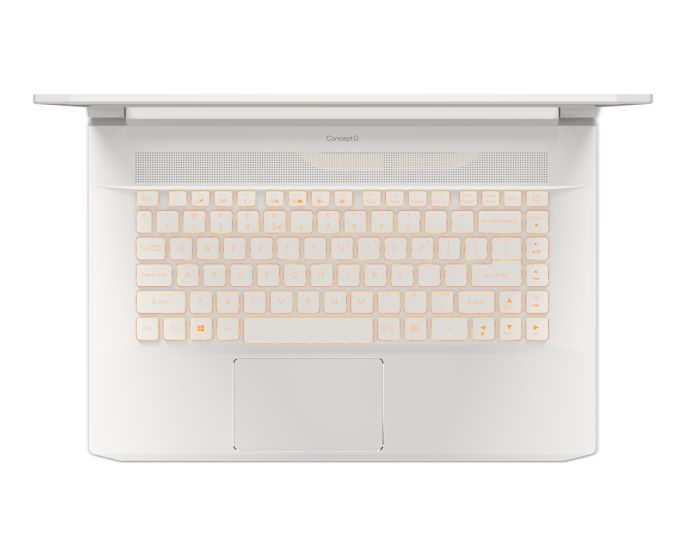

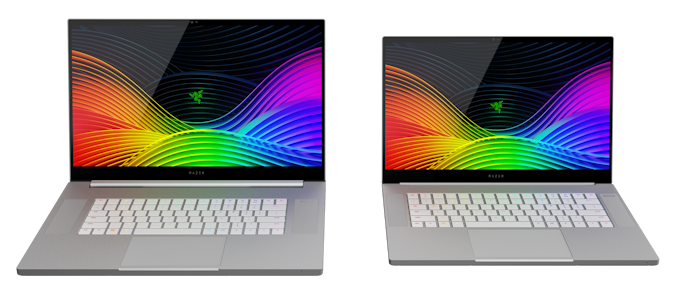
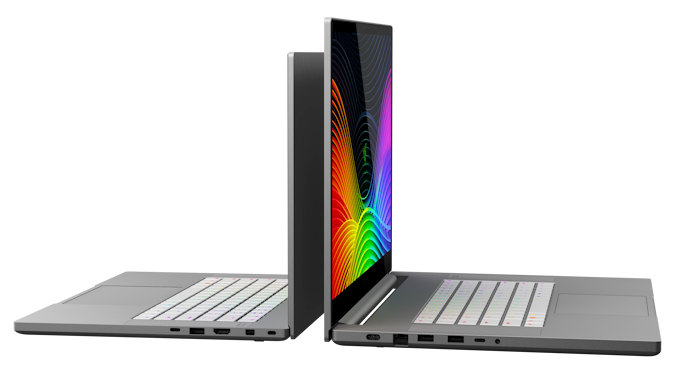
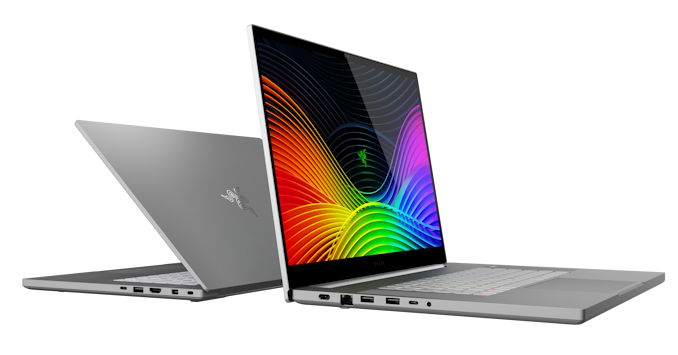
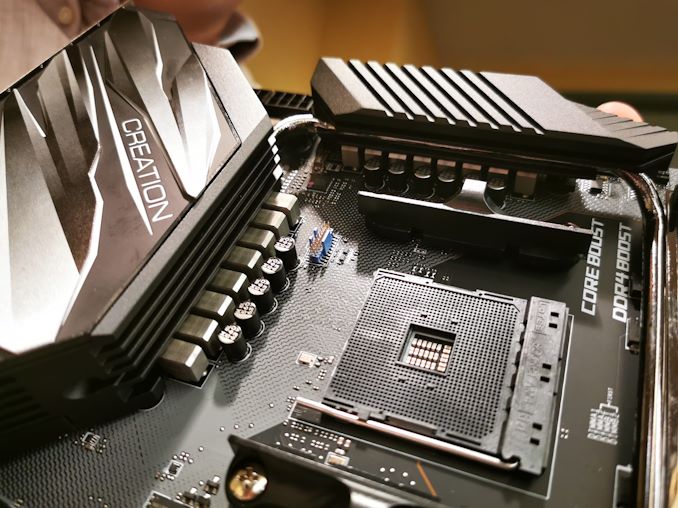
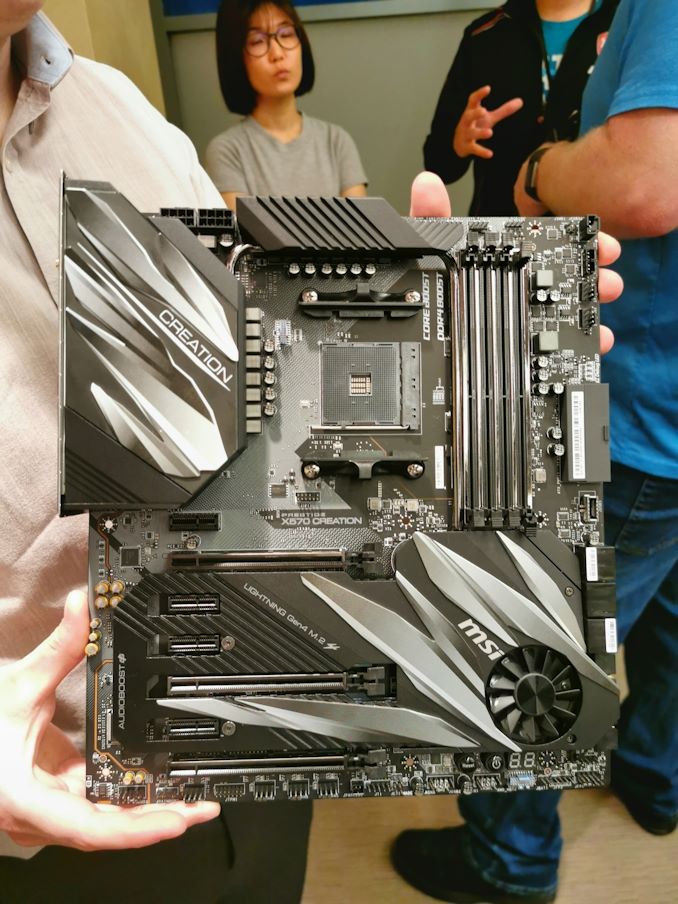

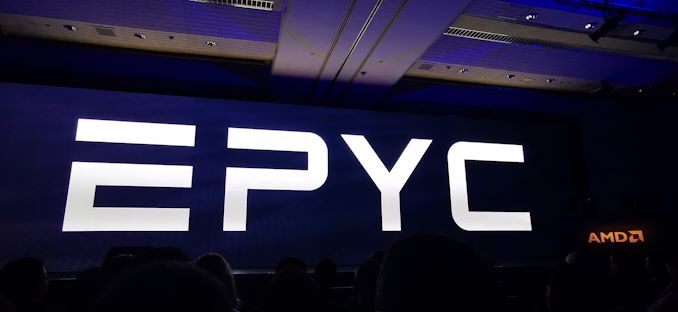






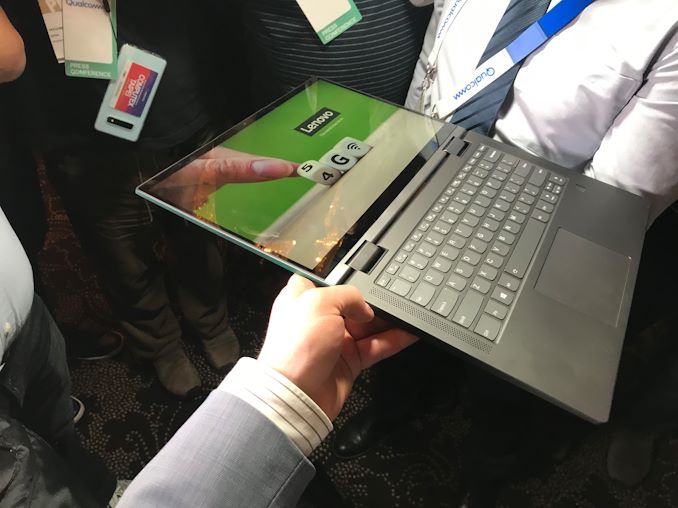


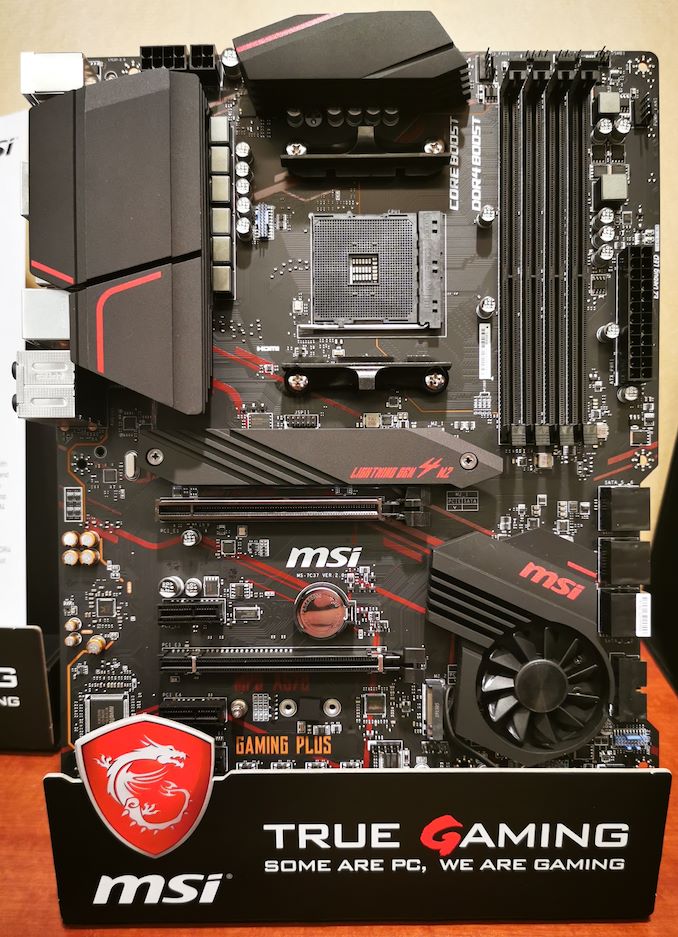
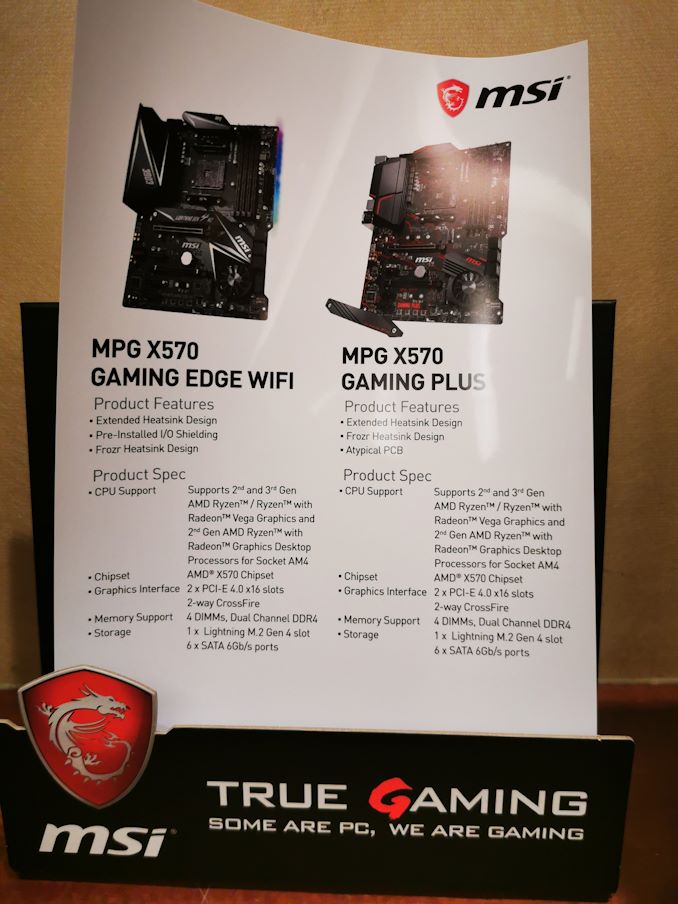

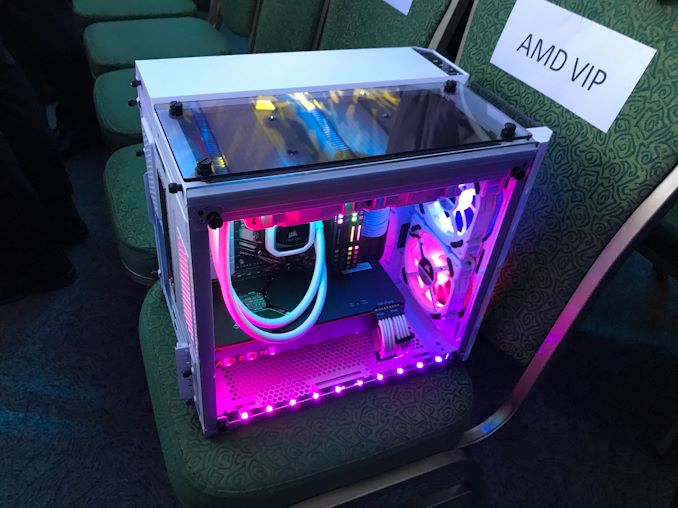

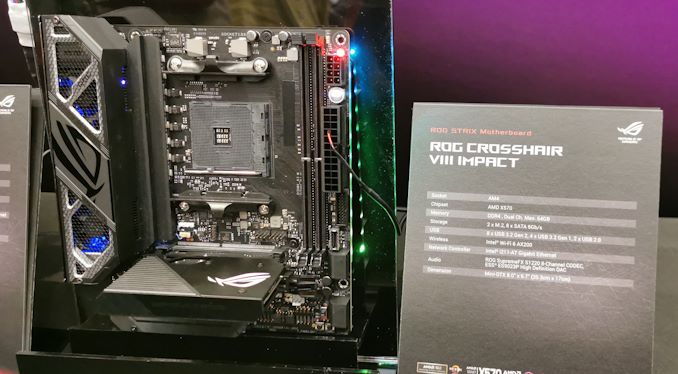
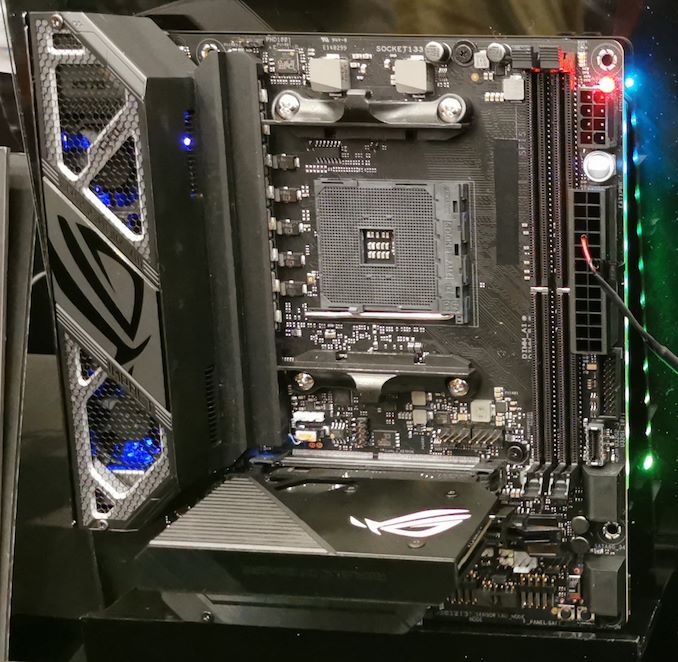
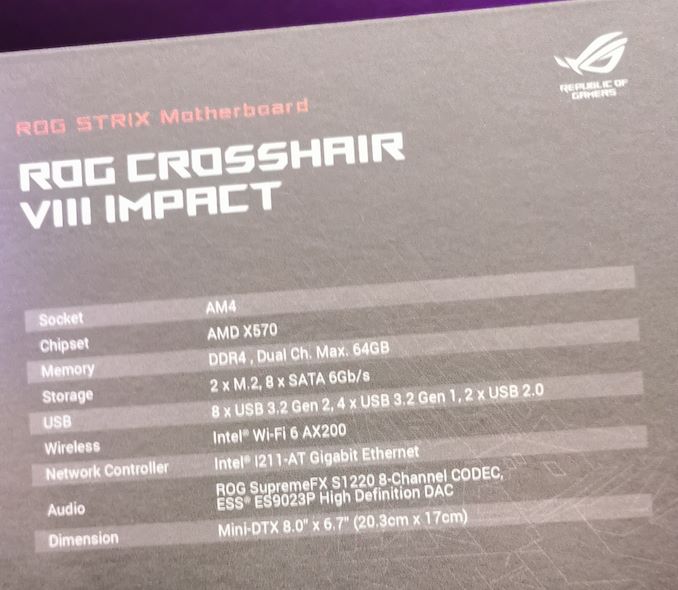
















Bookmarks